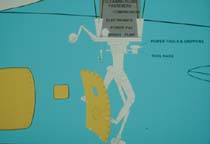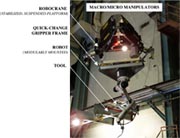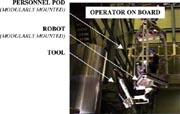Air Craft Maintenance
Air Craft Maintenance
A newly developed robotic crane is being installed into Air Force maintenance hangars to position personnel and tools around large aircraft. This robotic crane was originally developed at the National Institute of Standards and Technology (NIST) as the RoboCrane, and was re-named the Aerial Multi-axis Platform (AMP) for Air Force installations at Warner Robins Air Logistics Center and other maintenance depots. The RoboCrane/AMP is a modular system that uses six similar hoists and cables to stabilize and maneuver a suspended work platform from a ceiling structure or overhead gantry. The computer control system enables an operator to intuitively drive the suspended platform in all directions from a single joystick, while automatically adjusting the cable lengths to provide the desired position, orientation, and velocity throughout a large work-volume.
There are several benefits associated with the RoboCrane/AMP system that are not possible with conventional cranes. The multiple cable design provides inherent stability of the suspended platform, so an operator can control it from the ground or while riding on the platform itself. This allows remote acquisition, precision placement, and even assembly of large payloads without taglines for steering. It also enables deployment of personnel wielding tools to perform tasks. Since it is a robotic crane, it can be programmed to perform automated trajectories or use sensors to automatically maintain stand-off distances and provide collision avoidance. The distributed, lightweight design enables installation into existing building structures, often without additional reinforcement, or it can be deployed from fabricated space frames to provide these capabilities. The modular components, which consist mainly of hoists, cables, pulleys, aluminum trusses, steel connectors, and a computer controller, all fit into a single 20 foot ISO container and allow quick assembly/installation on-site, which is particularly beneficial for expeditionary applications.

Figure 1: a) Conventional ground-based access equipment is difficult to position accurately and inefficient due to ground clutter around the aircraft. b) Conventional aircraft maintenance techniques are manually intensive, complicated by protective clothing and breathing apparatus in some instances, and prone to fatigue and injury. c) A RoboCrane/AMP is shown with an enclosed operator cab and front-mounted tripod manipulator, which deploys four blasting nozzles to drastically increase efficiency and improve operator ergonomics in the depaint process. D) A lightweight RoboCrane/AMP is shown suspended from the hangar ceiling to improve positioning accuracy on large airplanes while minimizing ground clutter.
(Click on the photo to enlarge the image)
Large Aircraft Depaint Presentation
(click on icon to download presentation)





